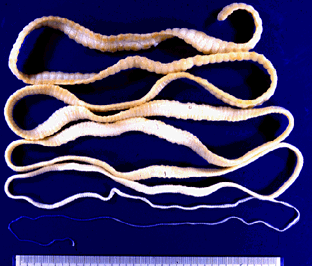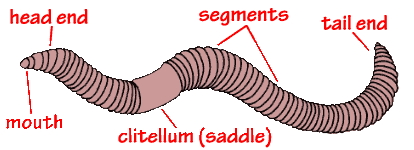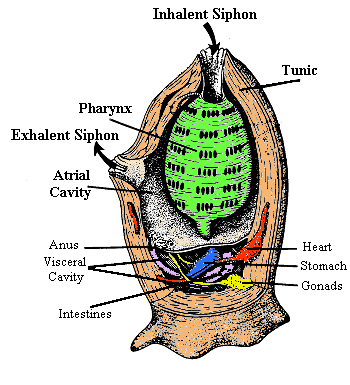
Animals




Animal Diversity and Classification
Before beginning this lab activity, be sure that you have read through the lab handout.
Now, using the images and diagrams below, you will sketch and label the organisms as indicated. You can print and draw on the lab handout itself OR you may do so on a blank sheet of paper. If you have a tablet that you take notes/draw on then you may also draw digitally. You will complete 10 total drawings.
It is okay if you aren't an artist- after all this is biology lab! Just take your time and try to draw the 1) overall shape of the organism as best you can and 2) draw and label any distinctive features and structures- particularly those structures you are asked to label. You do not have to color your drawings- but you can if you want.
As you go, use the voicethread and/or the lab handout to identify 1-2 key characteristics of each animal. List these next to your drawing. When you are done, take a photo of your handout and upload to this week's discussion board along with the answers to the discussion questions. Contact your lab instructor with any questions.
Invertebrates
Group: Sponges
Label: using an arrow, indicate the direction of water flow in your drawing

Water enter through pores and exits through the main cavity called the osculum.

Sponges have porous bodies, and water enters through the pores. Inside the sponge body, specialized feeding cells trap food particles. Once filtered, the water exits the sponge through the cavity at the top called the osculum.
Short video showing the movement of water through a marine sponge.
Invertebrates
Group: Cnidarians
Label: Tentacles, gastrovascular cavity
Cnidarians have stinging tentacles that are used to stun and immobilize prey. They also have gastrovascular cavities where food can be slowly digested. Label these structures in your jellyfish sketch.


Invertebrates
Group: Mollusks
Label: shell, tail, foot, eyes, and mouth
Mollusks are soft-bodied animals that often have a hard outer, protective shell. Label the tail, foot, eyes, mouth, and the shell in your snail drawing.



Invertebrates
Group: Flat Worms
Label: hooks, sucker

One type of parasitic flatworm is the tapeworm. Its hooks and suckers allow it to embed itself in its hosts intestines, where it can survive for long periods of time while stealing nutrients from the hosts body. Draw the head (aka scolex) of a tapeworm and label the hooks and suckers.
Optional video on pork tapeworm infections in humans. From the Animal Planet show "Monsters Inside Me."

Invertebrates
Group: Annelids
Label: segments

Annelids have segmented bodies. These segments allow the organism to better move about its terrestrial environment. Draw an earthworm and be sure to label the segments in your earthworm drawing.

Invertebrates
Group: Roundworms
Label: hooks
Roundworms are unsegmented and are named for their round, cylindrical body. Some species are parasitic and use hooks to embed and burrow into host tissues. Draw the head of the hookworm and label the hooks in your roundworm drawing.

Optional video on hookworms infections in humans and other animals. From the Animal Planet show "Monsters Inside Me."
Invertebrates
Group: Arthropods
Label: head, thorax, abdomen, wings, antennae
Insects are just one example of an arthropod. Recall that there are 4 sub-groups of arthropods (including arachnids, crustaceans, millipedes/centipedes, and insects).
Insects typically have 3 body parts: the head, thorax, and abdomen. Label these parts. Some insects may have antenna or wings as well. Label these in your drawing. Draw the cicada below as your example of an insect.



Video on arthropods from the Smithsonian Institution.
Invertebrates
Group: Echinoderms
Label: Arm, tube feet


Echinoderms include sea stars, sea urchins, sea cucumbers, and sand dollars. Sea stars have small structures on the bottom of their bodies called 'tube feet' that allow them to move around their habitat. Sea stars also have a unique water vascular system, that enables them to remove waste products from the body.
Short video on echinoderm diversity & tissue regeneration by National Geographic.
Invertebrate Chordates
Group: Lancelets
Label: mouth, tentacles, tail
The lancelets are very small invertebrates that typically live along the substrate around gravel and rocks. They may 'wiggle' among the gravel to stir up food particles. Label the lancelets mouth, tail, and tentacles.

Short video on how many biologists study lancelets to better understand human brains! Video from HHMI Biointeractive.

Invertebrate Chordates
Group: Tunicates
Label: Siphon
Tunicates are sometimes called sea squirts, as they can expel water to startle intruders or predators. Label the siphons, which they use to draw in and expel water.



Short video showing a group of tunicates in the ocean.